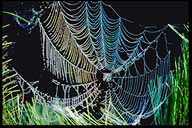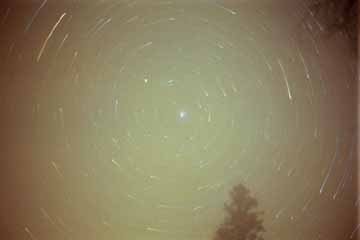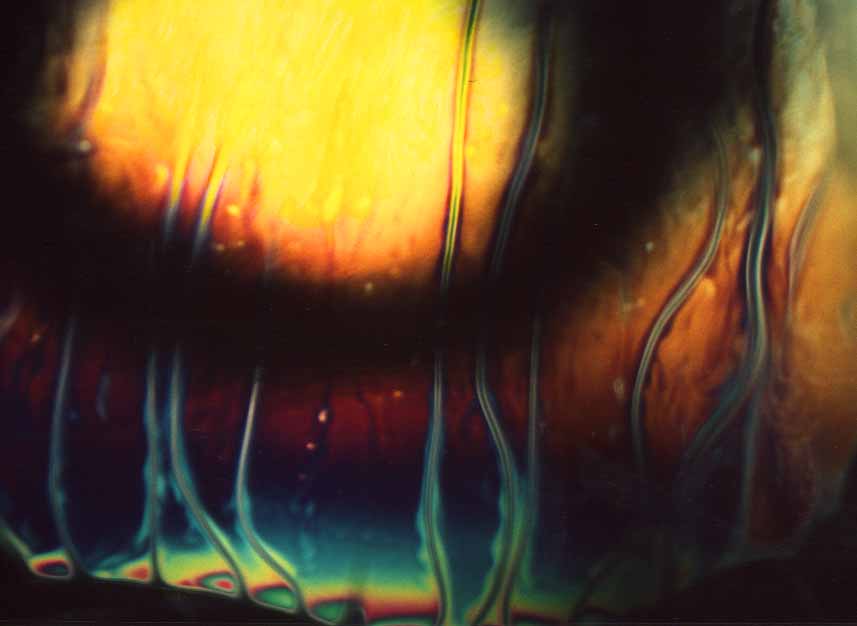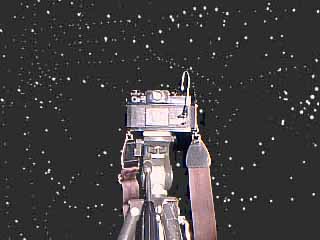Extending The Normal Limits
Through macro photography I learned to extend what I thought were the normal limits
of my vision. In other words I noticed things I had never noticed before. Macro photography
revealed to me the different colours of the spectrum in tiny drops of
water. Even when I was no longer looking through the camera lens I began to notice with
a "magnified sensitivity",
a dew drop on a tree branch or a spider web at large distances. By changing my position relative
to the drop,
the colour in the drop would change through the colours of the spectrum.

|
I became aware of other subtle perceptions. While photographing stars
I learned that the faint ones were invisible when looked at directly with
one's central vision (fovea
centralis) but became visible when viewed indirectly with one's peripheral
vision demonstrating that peripheral vision is much more sensitive to
light. Through long time-exposures the film revealed that stars are actually
different colours.
|

|

|
While observing the moving colour patterns on soap film surfaces through the viewfinder of the
camera I noticed that the same "colour" appeared different to each eye.
|
I learned to observe another phenomenon after photographing the strobe lights on communications
towers. Through normal observation these lights appear to flash on only once for a brief
fraction of a second every few seconds. The film through panning action of the camera
revealed that each one of those brief flashes in fact contained the numerous on and off flashes
caused by a strobe which I found in some cases to be a phenomenal 17 times! I learned to
observe this strobe action with the naked eye by "picking up the flashes of light" with my
peripheral vision while panning my head at the appropriate moment.

|
"Strobe-like" demonstration at a frequency of one, one-hundredths of a second:
|

|
This frequency is not fast enough to demonstrate the above experiment here. The sensitivity
of peripheral vision can however be demonstrated if you have noticed its ability to perceive the
flickering of light emanating from the screen of a monitor with a lower refresh rate.
To go off on a tangent link through the strobe at left to see the "Acme Strobe Company
Stage Set". |
Then there is the phenomenon of flickering white light which is observed
with peripheral vision in the absolute darkness in a forest at night or in a
dark room. Could this be the aura?
Go on a NightWalking
Trip.
Then there is the aurora of Mother Earth. See my animation of the
Aurora Borealis
in colour.
I am intrigued by what lies beyond the narrow range of our sensory
perceptions which occupy only a tiny fraction of the electromagnetic
spectrum.
As it turns out, not only electro-magnetic radiation, but the majority of life
forms, namely microbes, are invisible to the naked eye.
This does not prevent microbes from being responsible to a large degree,
for affairs on this planet. More than a billion years ago there was no free
oxygen in the oceans or atmosphere. Cyanobacteria (blue-green algae) in water
used sunlight through photosynthesis to convert carbon dioxide into sugar and
produced oxygen as a waste product. The dissolved oxygen reacted with the iron
in the oceans which precipated as rust on the ocean floor producing the material
from which steel is made. When all of the iron was oxidized, oxygen began to
accumulate in the atmosphere which is necessary for our existence. According
to Lynn Margulis
all life on Earth today derived from common ancestors. Bacteria not only are
the building blocks of life, but also occupy and are indispensable to every
other living being on Earth. We being more complex creatures are both surrounded
by them and composed of them. Instead of viewing ourselves as the pinnacle of
evolution, it may be more accurate to think of ourselves as a colony of closely
associated bacteria. Fully 10 percent of our own dry weight consists of bacteria,
some of which - like those in our intestines that produce vitamin B12 - we cannot
live without. The descendant of Precambrian bacteria are carried within the
cells of our own bodies in the form of mitochondria which burn sugar and oxygen
to generate energy.
BACK
to prINTS by INTS




